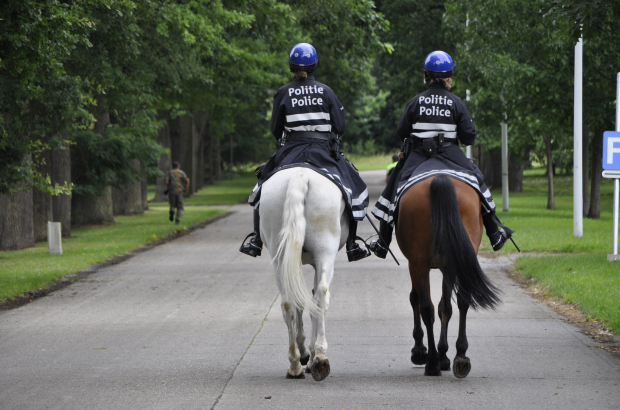- Daily & Weekly newsletters
- Buy & download The Bulletin
- Comment on our articles
Two police horses return home alone after losing their riders in Bois de la Cambre
Two horses of the federal police, mobilised in the Bois de la Cambre as part of an intervention to break up a large gathering, returned alone to the barracks in Etterbeek on Friday night, leaving their police riders behind.
According to an amateur video, the horses collided with a lamppost outside the Bois de la Cambre, where they had been deployed in the dispersion of several hundred young people, causing the officers to fall.
The two horses took the initiative to return to their boxes alone through the streets of Brussels after the collision at around 20.00 - a journey of about 4km. They took Avenue Victoria, Avenue Franklin Roosevelt, then passed through Square Marie-José before finally reaching Boulevard General Jacques and their stables at the barracks. To protect them on their journey, cyclists and pedestrians helped to slow down cars on the route home.
Benoît Van Houtte, the director of public security at the federal police, told reporters on Saturday afternoon that while the incident was unusual, he was not surprised that the two animals found their way back to the barracks without any problem: "The Bois de la Cambre is the training ground of our horses, since they were very young,” he said. “This is one of the first journeys you take on horseback. When you want to get them used to the noise of traffic, you go to the Bois de la Cambre and you come back."
"They really know this path by heart," he added, clearly impressed by the images circulating on social media of the horses returning home. "They even took the roundabouts in the right direction."
"Thank you to all the people who helped,” he continued. “There was a little show of solidarity with the horses that certainly prevented any accidents."
The Bois de la Cambre was the scene of a gathering that degenerated into riots on Thursday following a fake event announced on Facebook which attracted between 1,500 and 2,000 people. In a rarely seen show of force, a police cavalry charge was used to disperse the crowd, an effective tactic but one hardly used.
While the Belgian police have used horses since the 19th century, where charges to disperse crowds without using weapons were more common, in modern times they have been used mainly as a visible back-up presence and in situations where access to motorised vehicles is limited or impossible.
"When we have to intervene, to charge, very few people stay in front of us, in general people get out of the way,” said Benoît Van Houtte. “So, it can be effective but these days, it can't be the only way. It has to be done in support, with other means like water cannons, for example."
This is why federal police on horseback are a "support unit", called in, depending on events, by local police.
"Generally, the police on horseback are called for all public events such as festivals, football matches or demonstrations,” said Van Houtte. “But it's mainly a show of force, a deterring presence."
"The mounted police are much more visible to the public than the police on foot,” he continued. “In addition, the rider sees further and can intervene without dismounting, so he can remain in a safe position."
Referring to the incidents on Thursday and Friday, the director of public security assured the public that the use of a cavalry charge was a special occurrence. "What happened was a bit unusual, it was about covering a very large area and the police on the ground were too few,” said Van Houtte. “Normally officers stay aligned and together but, the riders had to separate to help the policemen on foot who were injured."
Images of a young woman being knocked over by the charge on Thursday caused shock when they went viral, despite the girl being uninjured and able to get up and leave the scene. Van Houtte explained that cases like this are exceedingly rare.
"This was an accident that the policeman could not avoid,” he said. “Normally we don't take this kind of action. What happened at the Bois de la Cambre on Thursday was different from a demonstration or strike action, for example. We had to intervene surgically. But usually, we deploy other ways to deal with large crowds."
As a result, Van Houtte concluded, the general opinion of the mounted police among the people is a positive one. "The public is very rarely aggressive towards our riders, in fact people take more time to talk with them. People also ask us for news on the welfare of the horses after incidents."



















